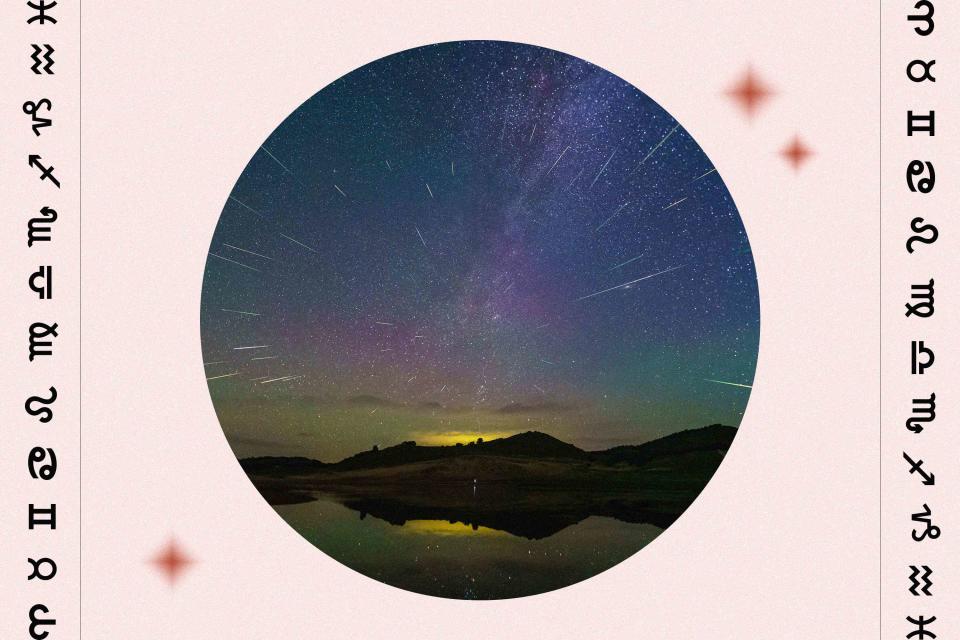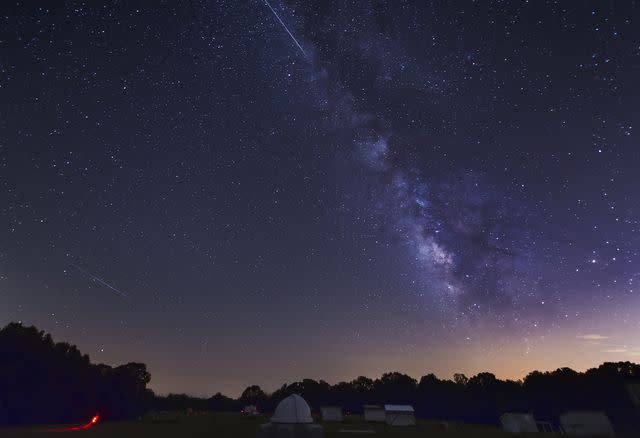How to Watch the Perseid Meteor Shower — and Another Northern Lights Display!
This month's Perseids meteor shower coincides with another Northern Lights display

Getty
Perseid Meteor ShowerA starry starry night is upon us!
Meteor shower season is in full swing with the Perseids next to peak, a highly-anticipated star-centered spectacle that arrives on the heels of the rare double meteor shower that took place at the end of July.
Following the Delta Aquariid and the Capricornid overlap late at night on July 30, the Perseid meteor shower is expected to peak in mid-August. Just when stargazers thought the double meteor shower couldn't be topped, the Perseids are ready to amaze.
In fact, NASA considers the Perseids "the best meteor shower of the year!" This is because of their vibrant appearance as they soar through the night sky, in addition to the number of meteors that are predicted to shoot.
It get's better, too! The Perseids are predicted to align with another round of Northern Lights that are expected to color the sky in the United States just days before the meteor shower peaks. The National Oceanic and Atmospheric Administration issued a moderate G2 geomagnetic storm watch, likely resulting in a beautiful display under the right conditions.
Fortunately for those who are looking to catch a glimpse of the celestial scene, viewers won't have to contend with a super bright moon that would likely drown out the starry display. This month's full moon, nicknamed the Sturgeon Moon, rises days after the shower's peak.
August's moon is transitioning out of its new moon phase, which peaked on Aug. 4 this year. That means, its appearance is slowly evolving from a blacked-out display to a radiant supermoon glow in the coming weeks.
Adding more excitement to the cosmic event is the potential for another Northern Lights display. According to the National Oceanic and Atmospheric Administration (NOAA) Space Weather Prediction Center, a geomagnetic storm watch for Aug. 9 through Aug. 11, coinciding with the meteor shower.
Until then, read on for how to watch the Perseid meteor shower this year!
Related: Your Horoscope for August: Find Grounding Amidst the Chaos
When are the Northern Lights expected to take place?

Artem Tsehelnyk/Suspilne Ukraine/JSC "UA:PBC"/Global Images Ukraine via Getty
NOAA issued a G2 (moderate) geomagnetic storm watch anticipated for Aug. 9 and possibly around Aug. 11 resulting from a coronal mass ejection (CME), which is an eruption of solar material.
A geomagnetic storm can result when CMEs arrive at Earth. "Watches of this level are not uncommon," according to the agency.
The Northern Lights, also known as aurora borealis, may become visible over some northern and upper Midwest states, with visibility potentially stretching from New York to Idaho.
What is the Perseid meteor shower?

NASA deems the Perseids "the best meteor shower of the year" due to its beautiful appearance and bountiful display in the night sky. They are known to leave long "wakes" of light and color in their trail as they streak across the Earth's atmosphere.
While spotting a shooting star is often rare, the Perseids are an exciting meteor shower due to the ample opportunities they give stargazers to spot one (or a few) as they whiz through the cosmos.
If viewing conditions are clear, approximately 50 to 100 meteors can be seen per hour!
When does the Perseid meteor shower peak?
The Perseids are active from July 14 to Sept. 1 — but like all meteor showers, it shoots the most stars at its peak. This year, the Perseids peak in the early morning hours of Aug. 12.
According to NASA, stargazers should be able to catch a glimpse of the spectacle during the late night hours the night before the meteor shower peaks. That means, head outside and cast your eyes to the dark sky on Aug. 11, too!
If you missed out on Aug. 11 and Aug. 12, there's a chance to catch some straggling stars on Aug. 13 — however, the space organization notes the Perseids "tend to fall off rapidly after their peak."
Related: Here's What Leo Season Means for You, According to Your Zodiac Sign
How to watch the Perseid meteor shower?

The Perseid meteor shower will be viewable all throughout the night sky when watching from Earth. Still, there are specific areas to narrow your focus to maximize your chances at spotting the shooting stars.
All meteor showers have a radiant, or a point in the sky where the stars appear to shoot from in the night. For the Perseids, the radiant is the Perseus constellation (which is how the meteor shower got its name).
However, it's important to note that the radiant isn't the actual source of the meteor shower. "The constellation for which a meteor shower is named only serves to aid viewers in determining which shower they are viewing on a given night," according to NASA.
Another factor to consider when trying to spot Perseids is the weather, just like all meteor showers. Clear skies (ie, no fog, rain and clouds) and a non-invasive moon are the best conditions for viewing.
While the weather is unpredictable, star seekers are in luck regarding the moon's effect on visibility as it's in the first quarter phase and about 50% illuminated when the Perseids peak. This month's full moon doesn't rise until Aug. 19, so its glow won't drown out the stars.
Related: All About July's Full Buck Moon and What It Means for Your Zodiac Sign
What is the next meteor shower after the Perseids?
The next meteor shower to peak after the Perseids are the Orionids. They peak between Oct. 20 and Oct. 21, though they are active from Sept. 26 through Nov. 22, 2024.
For more People news, make sure to sign up for our newsletter!
Read the original article on People.


